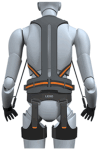Effect of Wearable Exoskeleton Robots on Muscle Activation and Gait Parameters on a Treadmill: A Randomized Controlled Trial
- PMID: 40217998
- PMCID: PMC11989089
- DOI: 10.3390/healthcare13070700
Effect of Wearable Exoskeleton Robots on Muscle Activation and Gait Parameters on a Treadmill: A Randomized Controlled Trial
Abstract
Background: Exoskeleton robots are emerging as a transformative technology in healthcare, rehabilitation, and industrial settings, providing significant benefits such as improving gait restoration and preventing injuries. These robots enhance mobility for individuals with neuromuscular disorders by providing muscular assistance and reducing physical strain, while also supporting workers in physically demanding tasks. They improve gait efficiency, muscle activation, and overall physical function, contributing to both rehabilitation and occupational health. Objective: This study aims to investigate the impact of exoskeleton use on muscle activation patterns, fatigue levels, and gait parameters in healthy individuals. Methods: Thirty-six participants engaged in a randomized sequence gait experiment on a treadmill for 30 min, both with and without an exoskeleton, with electromyography (EMG) and OptoGait measurements collected during the sessions. A one-week washout period was implemented before participants switched conditions. Results: In the Maximum voluntary contraction (MVC) analysis, significant differences were observed in the Rectus femoris (RF) and gastrocnemius(GM) when wearing the exoskeleton robot compared to not wearing it. At 10 min, 20 min, and 30 min, the differences were statistically significant (p < 0.05) for all muscles. In the muscle fatigue analysis, significant differences were observed in RF, GM, vastus medialis (VM), and hamstring(HS) at 10 min, 20 min, and 30 min (p < 0.05). In the step length and stride length analysis, significant differences were observed at 10 min and 30 min, but no differences were found at 20 min (p < 0.05). Conclusions: This study demonstrates that the use of the exoskeleton robot significantly impacts muscle activation, muscle fatigue, and gait parameters. The results emphasize the potential benefits of exoskeletons in enhancing mobility and reducing muscle strain, providing important insights for rehabilitation and occupational applications.
Keywords: loading response; maximal voluntary contraction; muscle fatigue; pre-swing; stance phase; step length; stride length; swing phase.
Conflict of interest statement
The authors declare no conflicts of interest.
Figures
Similar articles
-
Adaptive ankle exoskeleton gait training demonstrates acute neuromuscular and spatiotemporal benefits for individuals with cerebral palsy: A pilot study.Gait Posture. 2022 Jun;95:256-263. doi: 10.1016/j.gaitpost.2020.11.005. Epub 2020 Nov 11. Gait Posture. 2022. PMID: 33248858 Free PMC article.
-
Gait performance and foot pressure distribution during wearable robot-assisted gait in elderly adults.J Neuroeng Rehabil. 2017 Nov 28;14(1):123. doi: 10.1186/s12984-017-0333-z. J Neuroeng Rehabil. 2017. PMID: 29183379 Free PMC article. Clinical Trial.
-
Correlation between cardiopulmonary metabolic energy cost and lower-limb muscle activity during inclined treadmill gait in older adults.BMC Geriatr. 2021 Aug 23;21(1):469. doi: 10.1186/s12877-021-02401-9. BMC Geriatr. 2021. PMID: 34425788 Free PMC article.
-
Contributions to the understanding of gait control.Dan Med J. 2014 Apr;61(4):B4823. Dan Med J. 2014. PMID: 24814597 Review.
-
Powered single hip joint exoskeletons for gait rehabilitation: a systematic review and Meta-analysis.BMC Musculoskelet Disord. 2024 Jan 20;25(1):80. doi: 10.1186/s12891-024-07189-4. BMC Musculoskelet Disord. 2024. PMID: 38245729 Free PMC article.
References
-
- Sivan M., O’Connor R., Makower S., Levesley M., Bhakta B. Systematic review of outcome measures used in the evaluation of robot-assisted upper limb exercise in stroke. J. Rehabil. Med. 2021;43:181–189. - PubMed
-
- Molteni F., Gasperini G., Cannaviello G., Guanziroli E. Exoskeleton and end-effector robots for upper and lower limbs rehabilitation: Narrative review. PM&R. 2018;10:S174–S188. - PubMed
LinkOut - more resources
Full Text Sources




